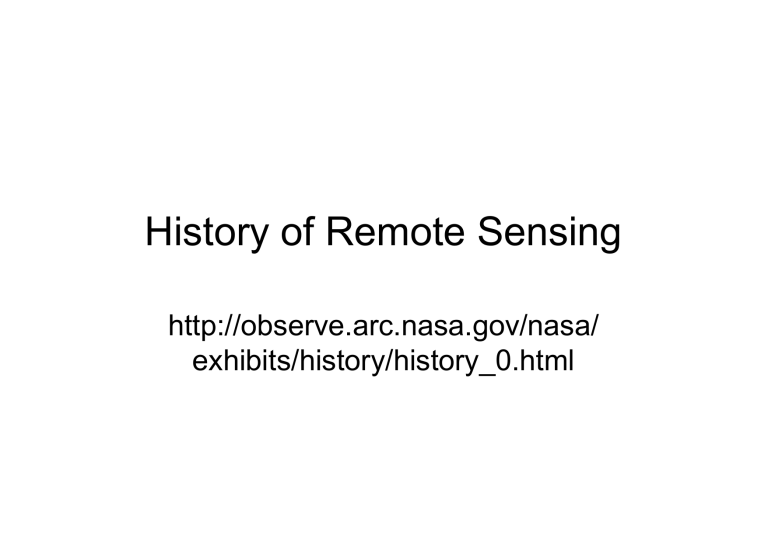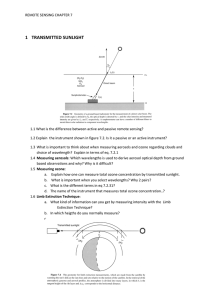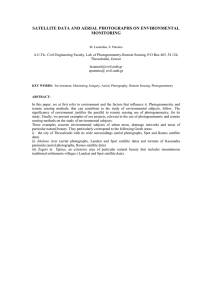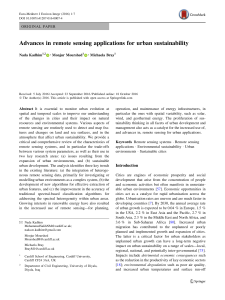1 History of Remote Sensing
advertisement

History of Remote Sensing http://observe.arc.nasa.gov/nasa/ exhibits/history/history_0.html •remote sensing is simply obtaining information about an object without coming into direct physical contact with it •Galileo -- telescope : 1609 –spots on the Sun –imperfections on the Moon –the Milky Way was composed of a myriad of faint stars. –satellites orbiting Jupiter •The First Aerial Photographer: 1859 –Gaspard Felix Tournachon (Nadar), was a famous French photographer and balloonist who carried his bulky cameras aloft. –His goal was to make land surveys from aerial photographs. •The US Army Balloon Corps:1862 –Professor Thaddeus Lowe believed that balloons could be useful for reconnaissance. –President Lincoln authorized the US Army Balloon Corps –Despite its advantage to the North during the American Civil War, the unit was deactivated in 1863. Balloons had a not-surprising tendency to draw enemy fire. •The Bavarian Pigeon Corps: 1903 –attach a very light camera to a carrier pigeon. –cameras took a picture every thirty seconds as the pigeon winged its way home. •Photos from an Aeroplane: 1909 –Wilbur Wright was the pilot for two notable events in remote sensing history. –The first photographs from an aircraft were taken by Wilbur's passenger, L. P. Bonvillain, on a demonstration flight in France in 1908. –the first aerial motion pictures were taken in Italy when another photographer accompanied Wright. •The Great War: 1914-1918 –The biplane replaced the balloon for observing enemy positions in the World War I. –the Germans acquired 4,000 photos a day as part of the planning for their last great offensive of 1918 –the US Army made over one million prints in the last four months of the war. •The Buzz Bomb: 1944 –As Royal Air Force photo interpreter was studying stereo air photos of the German experimental station –She had discovered the infamous V-1 "buzz bomb," a jet-powered missile –the newer V-2 was a liquid-fueled rocket. –Post-war experiments and tests with captured V-2s led, in the late 1950s, to the development of satellite launch vehicles and the exploration of space. •The Cuban Missile Crisis: 1962 – In the fall of 1962, there were unconfirmed reports that the Soviets were installing intermediate-range nuclear missiles in Cuba. – Remotely sensed imagery from satellites, and especially from high flying U-2 airplanes, provided incontrovertible proof that the rumors were true. – Soviet Premier Khrushchev and US President John F. Kennedy in October 1962 brought the world to the brink of war. Both superpowers relied heavily on interpretations of remotely sensed images to make their assessments and decisions. •Apollo Program – The mission to the Moon needed maps of the lunar surface, especially of the proposed landing sites. – Apollo 8 returned the first pictures of the Earth from deep space (1968). – Images from the Apollo 9 multispectral four-lens camera were digitized and used to develop techniques for processing Landsat data •Civilian Satellite Remote Sensing: 1972 – In late July 1972 NASA launched the first Earth Resources Technology Satellite (ERTS-1). – The multispectral data provided by the on-board sensors led to an improved understanding of crops, minerals, soils, urban growth, and many other Earth features and processes. – The name of the satellite, and those that followed, was soon changed to a more pleasant-sounding Landsat. Landsats 2 through 5 have provided more data about the Earth than can ever be analyzed. •The Ozone Hole: 1985 – Ozone depletion over Antarctica, first noted by British scientists, was confirmed by measurements from the Nimbus-7 Total Ozone Mapping Spectrometer (TOMS), launched in 1978. – Since then, TOMS has made daily polar ozone maps of an ozone hole as large as the United States. Satellite data were invaluable in supporting the first Montreal Protocol, wherein forty nations agreed to a fifty percent reduction in the use of chlorofluorocarbons by 1999. •Chernobyl: 1986 – On April 26, 1986, one of the nuclear reactors in Chernobyl, Ukraine, exploded, spewing large amounts of radioactive materials into the atmosphere. – Images from US and French remote sensing satellites monitored the activity at the site. Even after the fire was out, the heat from the reactor was detected by infrared sensors in orbit. The reactor complex is the green rectangular area located just to the left of the black cooling pond. The use of remote sensing imagery to monitor emergency situations is becoming a well-established part of the field of emergency management. •Deforestation: 1986 – Detecting changes through time is one of the most powerful uses of remote sensing. – These Landsat images, taken in 1975 (left) and 1986(right), disclose how many acres of forest lands were converted to agricultural use in the Brazilian state of Rondonia. – The fishbone pattern of roads radiating from the major highway indicates the changes. NASA researchers have estimated that 9,000 square miles have been converted from forest to agriculture in this area of Brazil. •Supernova: 1987 – Oscar Duhalde was outside taking a break from his telescope at the Las Campañas Observatory in northern Chile. In the southern sky he noticed a bright object he had never seen before near the Tarantula nebula. – The star that exploded was a blue super giant; the light from it had been traveling for 160,000 years through space before reaching the Earth •Oil Field Fires, Kuwait: 1991 – The Kuwaiti oil field fires were easily visible from space. Astronauts aboard the space shuttle in the spring of 1991 captured this image of Kuwait. – It shows a few of the smoke plumes from the 700 oil wells blown up by the defeated Iraqi army as they fled Kuwait. The smoke plume reached about 16,000 feet, and black rain fell in parts of Iran and Saudi Arabia. •Hurricane Andrew: 1992 – Hurricane Andrew was the most costly natural disaster in US history, sweeping into heavily populated south Florida with winds of up to 160 mph. – human casualties were low because of advance warning from satellites. High-resolution satellite images also allowed a threedimensional reconstruction of the hurricane, which aided forecasters in predicting hurricane movements. More accurate storm position forecasts enable emergency managers to conduct evacuations in threatened areas. •Mississippi River Flooding: 1993 – The Midwestern US floods of 1993 are best seen and understood from a satellite's viewpoint. These views of St. Louis before and during the flood illustrate how remote sensing can be used to assess changes and aid in emergency planning and remediation efforts . Other information •http://www.geog.ucsb.edu/~jeff/115a/remo tesensinghistory.html •http://ccrs.nrcan.gc.ca/org/history/index_e. php •http://employees.oneonta.edu/baumanpr/g eosat2/RSHistory/HistoryRSPart1.htm •http://www.yc.ycc.utokai.ac.jp/ns/cholab/RSfun/english/RS_QA/RS_QA01.swf







